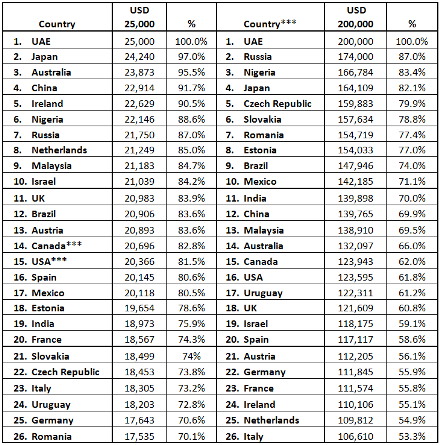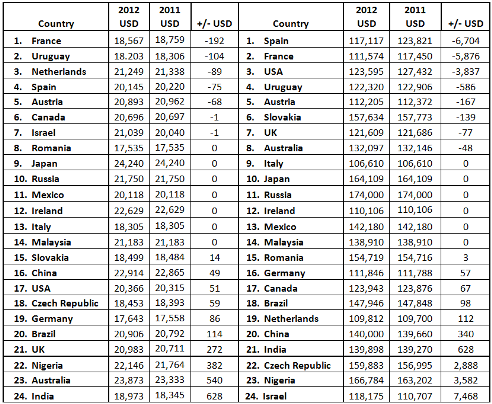The yawning gap between personal taxes in high- and low-tax economies has grown even wider over the last year, according to research by UHY, the international accounting and consultancy network.
Major European economies* in UHY’s research imposed an average USD 1,784 tax rise on those earning USD 200,000 over the last year compared to an average USD 266 tax cut in the BRIC emerging economies.
Low earners on USD 25,000 in the studied major European economies saw their taxes remain the same between 2011 and 2012, compared to an average tax cut of USD 198 in the BRICs.
UHY tax professionals studied data in 26 countries across its international network, including all members of the G8 and the emerging BRIC economies. UHY calculated the basic ‘take home pay’** of a single, unmarried employee after income taxes and employee social security contributions are deducted for salaries of USD 25,000, USD 50,000, USD 200,000, USD 250,000, and USD 1,500,000.
UHY says that the broadening gap has been driven by struggling European economies raising taxes to plug gaps in their budget deficits. UHY warns that this is making European economies even more uncompetitive compared to rival low tax economies.
Ladislav Hornan, chairman of UHY, says: “The personal tax gap between Western Europe and the rest of the world continues to grow larger. The distinction is sharp. Western European countries make up the five highest taxing economies in almost every tax bracket we looked at. Countries like China, Estonia, and Brazil consistently had the lowest tax burden.”
“Countries like France or Italy have had relatively high taxes for some time, but this year has seen other debt-laden European economies join them. For example, Spain has seen big tax rises for high earners as governments have tried to fund budget shortfalls.”
Ladislav Hornan adds: “The big European economies need to be very careful. They are putting a lot of pressure on individuals. There is a ‘brain drain’ risk for some countries with high personal taxes, particularly amongst internationally mobile high earners. For example, South-East Asia in particular has been increasingly attracting professionals from Europe. Losing talented workers and the taxes they pay will make it even harder for countries to close deficits.”
“Traditionally, the EU has been able to offset the effect of high taxes by offering a wide range of public services. However, tax rises in some EU countries have come hand-in-hand with swingeing cuts to public services.”
The BRIC countries – Brazil, Russia, India, China – all have some of the lowest levels of personal tax and social security contributions. The average taxpayer in a BRIC country will keep 85% of their income at USD 25,000 and 75% at USD 200,000. This compares to just 80% and 62% for the same average taxpayers in G7 countries.
The G7 could only manage an average tax cut of USD 31 for those earning USD 25,000 from 2011 to 2012, compared to the average USD 198 tax cut in the BRIC emerging economies.
Two of the countries imposing the five highest tax rises between 2011 and 2012 for those earning USD 200,000 were G7 countries: the US and France.
Ladislav Hornan adds: “The low tax economies, not all of which are developing economies, have been able to maintain or cut their tax rates over the past year.”
There were six countries to take over 50% of incomes, all in Western Europe, and all for incomes over USD 1,500,000. Those countries were: France (54% income taken); Italy (52%); Ireland (52%); the Netherlands (51%); Spain (50%); and the UK (50%). France recently announced plans to introduce a dramatic marginal 75% tax rate on USD 1.3m+ (EUR 1m+) incomes from 2013.
Russia was the most consistently low-tax economy, appearing most often in the five lowest taxing economies across the pay brackets. Italy and France appeared most often in the five highest taxing economies.
Nikolay Litvinov, partner of UHY Yans-Audit LLC in Russia, a member of UHY, comments: “Russia’s 13% flat rate of income tax makes it very competitive compared to rival economies, especially at the higher end of the income scale. Russia is consistently one of the cheapest places to live in terms of income tax. These low tax rates may help convince young and entrepreneurial Russians to stay in the country, and they may even tempt expats to return.”
“A taxpayer earning USD 250,000 will take home over USD 80,000 more than they would if they lived in Italy.”
Bernard Fay of UHY Fay & Co in Spain, a member of UHY, comments: “Last year, Spain performed well compared to other European economies in terms of income taxes. However, there have been big tax increases at the higher end of the income scale, as well as cuts to public services.”
“With high unemployment, drastically cut public services, and high taxes for those in work, there’s a very real risk of a ‘brain drain’ in Spain: younger and experienced workers will look enviously at other EU countries. It says a lot that other parts of Western Europe are attractive to Spanish workers, when Western Europe as a whole is performing poorly compared to other regions.”
James Tng, Tax Partner, UHY Haines Norton in Australia and member of UHY, says: “Australia seems to have found the balance between a progressive and competitive tax system. Unlike other major industrial economies, Australia doesn’t have a huge debt burden to complicate things. Low taxes are offered for the lowest earners, but the taxes on high earners are still a lot lower than elsewhere.”
“There has been a general easing of the tax rates of low and middle income earners over the past decade, beginning with the introduction of a Goods and Services Tax in 2000.”
James Tng adds: “The low tax burden reflects the fiscal strength of the Australian economy, particularly in the decade prior to the global financial crisis. Australia entered the crisis with little debt and very little in the way of the social security structures that other major economies have to fund, particularly in Europe. Consequently, Australia hasn’t been forced to raise personal taxes.”
Figure 1 – Income kept by those earning USD 25,000 and USD 200,000 after personal taxes and social security contributions in 2012
Figure 2 – Change in income kept by those earning USD 25,000 and USD 200,000 from 2011 to 2012 (positive number indicates a tax cut)
Figure 3 - Income kept by those earning USD 25,000 and USD 200,000 after personal taxes and social security contributions deducted – BRIC countries in 2012
Figure 4 - Income kept by those earning USD 25,000 and USD 200,000 after personal taxes and social security contributions deducted – G7 countries in 2012
* Includes data from Germany, UK, Italy, Ireland, Netherlands, France, and Spain
** Including basic allowances
***Country data is city-specific e.g. US data are from New York City, Canadian from Toronto





